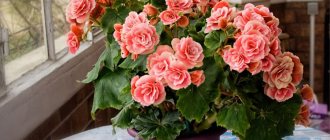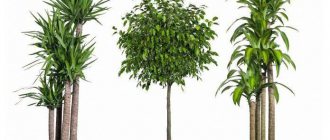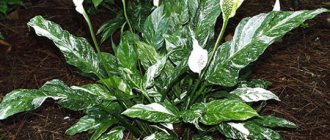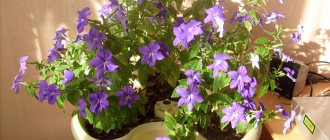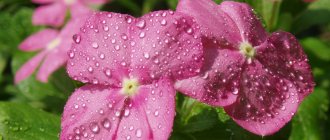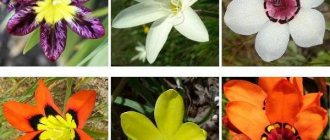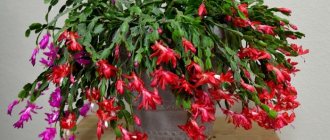The decorative foliage houseplant Caladium is part of the Araceae family. Under natural conditions, this plant can be found in the tropical latitudes of India and South America. It is very popular among gardeners due to its spectacular greenish leaf plates, which are decorated with a variety of spots, stains and patterns of contrasting shades. Due to the original shape and color of the leaf blades, the plant is also popularly called “Heart of Christ”, “Angel Wings”, and “Elephant Ears”.
Caladium foliage is very thin. The leaves are usually basal; they can be heart-shaped or arrow-shaped. The flower is distinguished by its demanding care and growing conditions. The plant has an average rate of development and growth. During the growing season, 10–12 new leaf blades are formed on the bush. The height of home caladium can vary from 0.3 to 0.6 m, while in wild conditions the plant can reach up to 5 m. In indoor conditions, flowers appear on the bush extremely rarely.
If you decide to decorate your home with caladium, then you need to remember that at the end of the growing season it begins a dormant period. At this time, all the foliage of the bush flies away and its development stops. In this regard, indoor caladium is most often cultivated as an annual plant.
Photo gallery
Description of the plant
Caladium belongs to the Araceae family and lives in tropical and subtropical zones of South America, mainly in Brazil. This plant first came to Europe in 1800 thanks to the French botanist Pierre Ventana.
Caladium is literally translated from the native dialect as “a plant that has edible roots.” Because of the amazing beauty of its leaves, it is called “angel wings”, “elephant ears” and “heart of Jesus”.
It is a herbaceous perennial plant. In its natural environment it reaches 5 meters in height, and its arrow-shaped leaves can replace an umbrella for local residents during rain. The life cycle of caladium is clearly divided into periods of dormancy and active growth. In March, young shoots form, which begin to dry out at the end of summer.
Often, inexperienced gardeners fail to bring it out of hibernation, and they refuse to grow it.
In some countries, certain types of caladium are used as a vegetable crop, since the tubers contain a lot of starch. The sap of indoor hybrid plants is poisonous - if it comes into contact with the skin and mucous membranes, it can cause a burn. Therefore, it should be placed in places inaccessible to children and animals. It is recommended to perform all care procedures with rubber gloves.
Coleus is similar in leaf shape and color to caladium. In terms of beauty and color, you can find a certain similarity with decorative begonia. His “elephant mugs” also resemble syngonium. However, the conditions of detention and the size of the crops are radically different.
The base of the plant is a tuber, it has a rough surface and a rounded shape. It grows about 7-12 cm in diameter. A fibrous rhizome is formed from it, on which buds form.
Like all representatives of the Araceae, the inflorescence looks like an ear surrounded by a veil and is no different in beauty. Small white buds appear on the peduncle in early spring, after the first leaves have formed. Flowering continues for several days, there is no aroma.
The leaves are valuable to florists:
- the size reaches 30 cm long and 15-17 wide;
- located on small cuttings;
- grow in the form of a rosette directly from the tuber;
- the shape of the leaf blade resembles a heart;
- On the surface there are drawings of various shapes, colors and sizes.
The lifespan of greenery reaches 5-6 months, and at the beginning of autumn they wither and a long period of dormancy begins for the plant.
Tips for Growing Caladium
You can buy caladium already with leaves or start with less expensive tubers. Growing seeds is a labor-intensive, long process. When purchasing, it is easier to tell what color the leaves will be if they have already appeared, but most packages of tubers have a photo of the coladium as a guide.
Tubers purchased from a nursery will have a large bud surrounded by smaller bubbles. As they grow, you will get several arrowhead-shaped leaves from each tuber.
Sometimes the tubers dry out a little and the tubercles are hard to see, but they should re-hydrate and sprout. Fresh tubers ordered from manufacturers will germinate the fastest.
One of the most important things to remember when caring for caladiums is that the tubers do not like the cold. If you plant them too early, the entire plant may rot.
It can be difficult to determine which end of the tuber to point upward because the roots grow on the same side as the leaves. Trust the tuber to know what to do and bury it about 5cm deep, with the tips facing up. When you pot, plant them in a moist peat moss mixture and slightly acidic soil with a pH (5.5 - 6.2). Once they sprout, move them to indirect light.
For outdoor planting, plant the tubers in a pot about 4-6 weeks before the last frost date. Wait until the soil warms to plant outdoors. Peat pots will make replanting plants easier. They don't mind transplanting, so starting them indoors gives you a better chance of getting early growth in your garden.
Signs and superstitions
“Colors are the smiles of nature,” said the popular 19th century writer James Hunt. A person surrounds himself with those colors and colors that help achieve harmony and mental balance. Green leaves with a bright red caladium pattern inspire you and give you confidence in your own abilities. Indoor plants are a symbol of life; they humidify the air and saturate it with special energy and oxygen.
There are no negative superstitions associated with caladium; it is not considered an energy vampire. The only danger is the toxicity of its juice.
Plants, according to the Taoist teachings of Feng Shui, must be placed strictly in the southern parts of the rooms, ideally this would be in the kitchen or living room. In this case, pots must be placed at a distance from people.
For lovers of compositions in the form of bonsai, caladium will not be suitable for sure, since its aesthetic qualities lie in a lush bush. And also biological properties (lack of a stem) will not allow creating such a form.
Diseases and pests
Caladium is susceptible to fungal diseases such as late blight, a wet bacterial rot that affects the tuber. To avoid these problems, you need to adjust the watering regime .
Pests that the plant may suffer from are aphids, spider mites and mealybugs. They need to be controlled with insecticides .
If you follow the rules of care and maintenance of the flower, it will reward you with lush leaves of extraordinary beauty and elegance.
Home care
During the growing season, the optimal temperature for the plant is 22-25°C. And during the rest period, the thermometer mark should not fall below 16 °C. Caladium can grow in the shade, but in this case the bright shade of the leaves will disappear. Intense diffused sunlight will allow the flower to show all the beauty of its variegated foliage.
Window sills oriented to the north, northeast and northwest will be best for it. In summer, it is allowed to take the pot outside, but it must be placed in partial shade, where there are no drafts.
A tropical guest needs to create a similar microclimate. Air humidity for caladium should be at 70%. This can be achieved by placing a tray with wet expanded clay or moss under the pot.
You cannot spray it - drops of water will lead to the appearance of brown spots; you can spray moisture into the air near the flower.
The peculiarity of the plant is the need to prepare it for the dormant period and special care in winter:
- In August you should stop feeding.
- From the moment the grass shoots begin to dry, you need to reduce watering.
- There is no need to trim dry stems; the resting phase begins in November.
- It is recommended to dig up the tubers and move them into a dry mixture of peat and sand.
- The soil should be slightly moist, this can be achieved by spraying.
Common problems
Caladium may exhibit atypical diseases if care rules are not followed.
- Leaves rot when water drops fall on them.
- Caladium languishes due to low air humidity and drafts.
- Leaves fall in the fall - the plant is preparing for a period of dormancy.
As you can see, the handsome caladium has certain care requirements. However, you can find an approach to it - you just need to be patient and meet all the necessary conditions. For all the work, the gardener will be rewarded with fireworks of bright leaves of original color.
And for the most curious, we invite you to watch a video about caladium
Diseases
The main disease of caladium is root rotting, which occurs from excessive watering. The appearance of rot is most likely during the first month after planting the tuber, when the leaves have not yet grown.
If, 1 or 1.5 months after transplantation, the caladium still has not acquired leaves, you should dig up the tuber and check whether it has rotted.
A healthy tuber under the skin is pale yellow.
Pests
Caladium may suffer from attacks by: aphids, spider mites, and mealybugs. Once pests are detected, the plant needs to be treated with insecticides.
Soil selection
The substrate for caladium needs to be light, with good access of oxygen to the roots. Ready-made soils for Dieffenbachia and spathiphyllum are suitable. The optimal acidity level is about 6 pH. You can make a soil mixture at home from the following components (in the ratio 1:1:1:0.5):
- peat;
- leaf soil;
- humus;
- sand.
To prevent rot from occurring, the bottom of the pot must be drained to 1/4 of the volume. You can use expanded clay for this.
Treating the soil with a solution of potassium permanganate or copper sulfate will help get rid of pests before planting.
Reproduction
Caladium grown from seeds often does not retain varietal characteristics. They begin to bloom on a flowering plant without artificial pollination, but quickly lose their germination capacity; sowing is allowed for the next season. The procedure is carried out in the following order:
- sowing is carried out in February in a nutritious soil mixture of leaf soil and sand in a ratio of 1:4;
- the substrate should be moistened and the seeds should be slightly buried;
- cover with film to create a greenhouse effect;
- germination must occur at a temperature not lower than 25 °C;
- regularly ventilate and moisten the soil.
The first shoots appear 15-20 days after planting. After the formation of the first 2 leaves, the seedlings must be picked and planted. Repeated transplantation is needed at the end of spring. By autumn, small tubers are formed, from which a fully formed plant grows the next season.
The easiest way to propagate caladium is by tubers. This should be done in February-March. Several division methods are possible:
- the mother tuber must be divided into parts so that two buds are preserved on each part;
- by children - separated and grown as a separate plant.
The separation tool must be sharp and sterile. The cut must be treated with charcoal to prevent rotting. A soil mixture of sand and peat is suitable for germinating tubers.
Planting and growing in the garden
Caladium should be planted in open ground when the weather becomes warm enough, that is, in the spring. Soil temperature is an important factor, as planting outside too early can lead to rot.
Choose well-draining soil, as caladiums survive in soggy conditions. You can understand what kind of soil is in a particular area by observing it after rain. If 5-6 hours after heavy rain there are still puddles of water, then do not approach such an area.
Be sure to carefully prepare the soil for planting. It needs to be loosened well and mixed in sufficient quantities of organic substances, for example, with:
- rotten manure;
- humus from leaves;
- bone meal.
Use 200-300 g of bone meal and 100-150 g of fertilizer per 1 m2.
Please ensure that the planting site is protected from direct sunlight. Caladiums do best in bright, indirect light or partial shade. The leaves of the plant can be damaged by strong winds, so it is better to plant in places protected from the wind.
Larger bulbs will need to be planted further apart. For the largest ones, you can allocate about 30 cm2 so that the plant has somewhere to spread its foliage. Small bulbs can be buried at a distance of 10-15 cm from each other. The bulbs can be cut into segments only in such a way that each of them contains a bud; however, this will result in decreased leaf production. The more buds, the more stems the flower will have.
Some gardeners recommend trimming the central bud on the bulb to encourage leaf growth. Each tuber has a large eye in the center, surrounded by many smaller ones. If you let it grow, the smaller cobs won't grow.
After planting, water the area generously to settle the soil around the tubers. Roots and shoots form after a few weeks, depending on the soil and air temperature.
Wintering
In warm, frost-free regions, caladiums can remain in the garden, but when grown in northern regions, they will need to be dug up for the winter. This should be done after the first light frost. By this time, almost all of their leaves have already died off. Trim them and leave the tubers in the fresh air for a couple of weeks to dry (choose a dry place).
Then place them in a mesh bag or box and cover them with dry peat moss. Store the plant in a dry place at average temperatures. Spray the bulbs with water from time to time to keep them hydrated. In the spring, after all danger of frost has passed, transplant your caladiums into pots or outdoors. It will grow again.
An option for the lazy: if you don’t want to dig up and bury, then just leave the roots in the ground and plant new ones in the spring.
Fertilizer application
It is necessary to start feeding caladium in June, after the shoots stop growing. The plant needs balanced chemical fertilizers, which should contain phosphorus, potassium and nitrogen in equal parts. Organic fertilizers include manure, litter, compost, humus (contain nitrogen), and wood ash is rich in potassium and calcium.
It is recommended to use universal mixtures for decorative foliage plants (such as Bona Forte, Agricola Aqua). It must be diluted in accordance with the instructions; lower concentrations are allowed. Nutrients must be added alternately once a week throughout the growing season. From August until the next season, feeding the flower is not required.
Excess nitrogen leads to a color change - green will prevail over the red tint.
Watering
The tropical flower loves regular watering. It is recommended to carry it out in small quantities, avoiding stagnation of water. The need for irrigation can be determined by the drying of the top layer of soil. Abundant watering begins after shoots appear and is reduced in August. During hibernation, spraying is necessary to prevent the tubers from drying out.
Soft water is needed, its temperature should be slightly higher than the environment.
Types of caladium with photos and names
The Caladium genus includes 15 main species, on the basis of which many varieties have been developed by breeders. They are different in size and color. Popular:
- Humboldt (caladium-humboldtii). It consists of a rosette of arrow-shaped leaves up to 10 cm long and about 5 cm wide. On the dark green surface of the leaves there are silvery spots in the center. The miniature variety Myriostigma has white speckles on the surface.
- Schomburg (Caladium schomburgkii). It is distinguished by oval, heart-shaped burdocks that grow up to 15 cm in length and up to 10 in width. The leaves, depending on the variety, can have a green (Venosum variety) or red (Erythraeum variety) base, on which there is a silver or yellow vein pattern.
- Bicolor (Caladium bicolor). The leaf blade reaches 30 cm in length. The Rosalie variety attracts with a bright green border on a red background. The Florida Cardinal hybrid has shiny crimson leaves with a bright green stripe along the edge. White Christmas is unique with its silvery surface with dark green stripes along the veins and spots.
Kinds
The genus Caladium includes 15 plant species. Some of them are quite popular and almost all have a marble effect.
Humboldt
This species can most often be found among home flower lovers, since it is the most unpretentious of all caladiums. The plant has no stem, but only a rosette from which arrow-shaped leaves emerge, measuring approximately 10*5 cm. Large spots of a silvery hue with veins extending from them are scattered in the center of the dark leaf plate.
Schomburg
The Brazilian guest boasts oval leaves, vaguely reminiscent of a heart, measuring 15x12 cm. On the face, the plates are decorated with silver-red patterns interspersed with green veins. The underside of the sheet is faded and unattractive.
Two-color
The newcomer from the Antilles produces arrow-shaped leaves, reaching a height of 30 cm. They are a beautiful red-crimson interspersed with light green color. The dormant period is very short, and the process of new leaves appearing almost constantly.
Since caladium is poisonous, it is not advisable to keep it in the bedroom. This may lead to an allergic reaction. If there are children and dogs in the house, they can bite off a piece and swallow it, which is fraught with harmful consequences - swelling of the larynx and burns of the mucous membranes. If the juice gets into the eyes, conjunctivitis and irreversible changes in the cornea will begin.
But in a house where sensible adults live, it is quite possible to start such a miracle. Just be sure to wear gloves when working with the plant.





